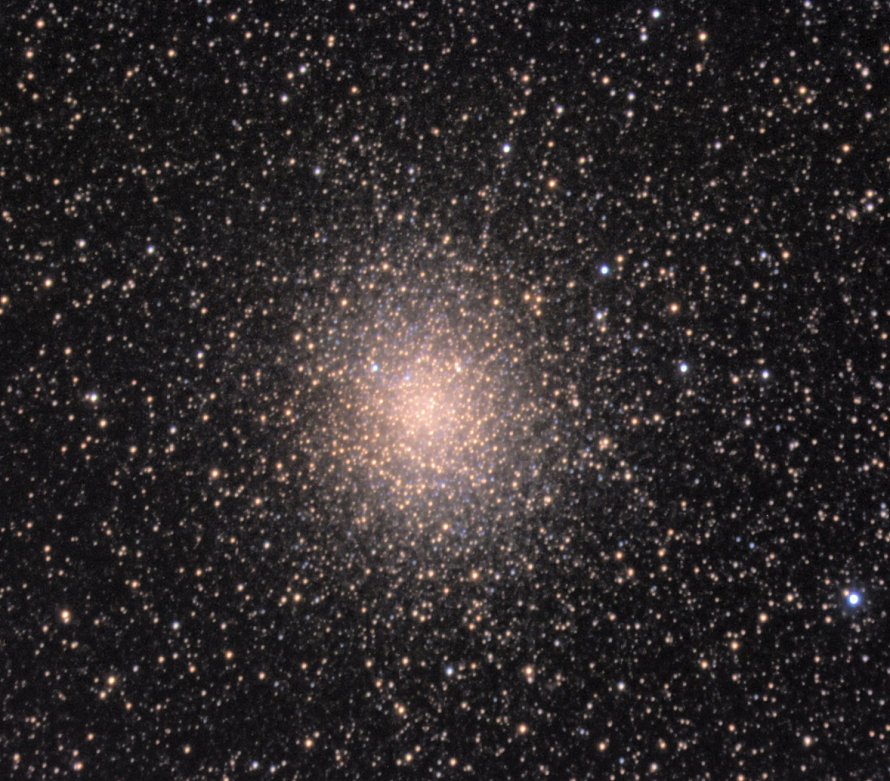M19 (NGC 6273)
Messier 19 (NGC 6273) is a globular cluster located in the constellation Ophiucus, in the Galactic Center of the Milky Way Galaxy in the Local Group of galaxies. M19 is 28700 light years away from Earth.
M19 is best viewed during mid-summer, is magnitude 7.5, and can be viewed with binoculars. M19 is 17' in apparent size. For reference, the full moon is 30'.
Observing difficulty: Easy
- Name:
- Type:
- globular cluster
- Constellation:
- Ophiucus
- NGC or IC:
- NGC 6273
- Magnitude:
- 7.5
- Viewing:
- binoculars
- Size:
- 17'
- Distance (light years):
- 28700 LY
- RA:
- 17h 2.6m
- Dec:
- -26 16'
- Season:
- mid-summer
- Milky Way location:
- Galactic Center
- Galaxy group:
- Local Group
- Messier Marathon #:
- 84
* The naked eye can see up to magnitude ~7-8 objects under ideal dark sky conditions.
A Unique Globular Cluster
Within the rich star fields of the constellation Ophiuchus lies the globular cluster Messier 19 (M19), one of the most peculiar clusters due to its noticeably oblate shape. Despite being relatively obscured by the Milky Way's dust, M19 continues to captivate astronomers with its dense population of ancient stars. This article delves into M19's discovery, its physical and stellar characteristics, brightness, and instructions on how to find and observe it.
Discovery and Observation
M19 was discovered by Charles Messier on June 5, 1764. Located approximately 28,000 light-years away from Earth, M19's faint light is easily obscured by urban light pollution. However, under dark skies with a telescope, it appears as a hazy, glowing patch of light.
Physical Characteristics and Magnitude
M19 stands out among other globular clusters due to its oval shape. It's thought that tidal forces from the Milky Way's core, relatively close at just about 5,200 light-years away, are responsible for its elongated appearance. Covering a space of about 140 light-years, M19 is home to hundreds of thousands of stars. Its brightest stars shine at a magnitude of 13, and the cluster as a whole has an apparent magnitude of about 6.8, making it invisible to the naked eye but a prime target for binoculars or a small telescope.
Stellar Composition
M19 is composed predominantly of old, red and yellow stars that give it a warm glow when viewed through a telescope. It has a high concentration of stars towards its core. The estimated age of M19 is around 11.9 billion years, making its stars some of the oldest known in the universe. This ancient population allows astronomers to study the early stages of the universe's evolution.
Astronomical Significance
M19's age and dense population make it a valuable subject for studying stellar dynamics and evolution. Its close proximity to the galactic center, as well as its noticeably oblate shape, also make it a fascinating object for studying the Milky Way's gravitational effects on globular clusters.
Finding and Viewing M19
Finding M19 involves locating the constellation Ophiuchus. It's best viewed during the summer months from the Northern Hemisphere. The cluster lies about 7.5 degrees south of the star Eta Ophiuchi. With binoculars or a small telescope, you can observe M19 as a fuzzy light patch. Higher magnification through a larger telescope can resolve the outer stars of the cluster and accentuate its elliptical shape.



